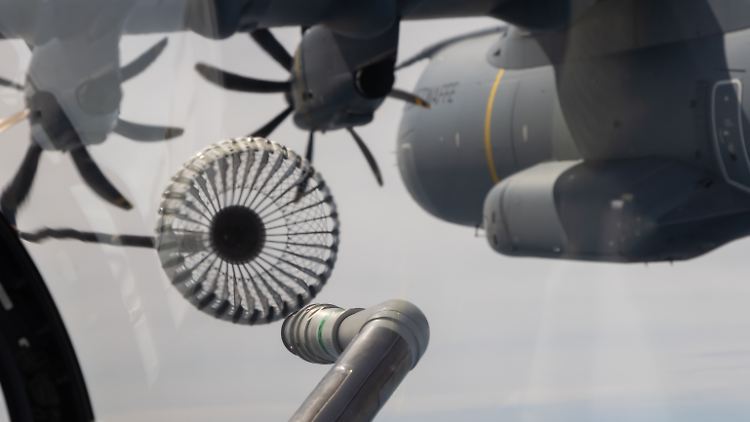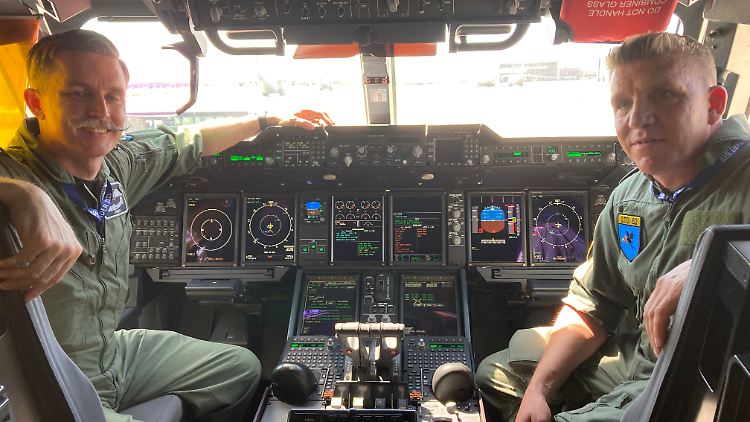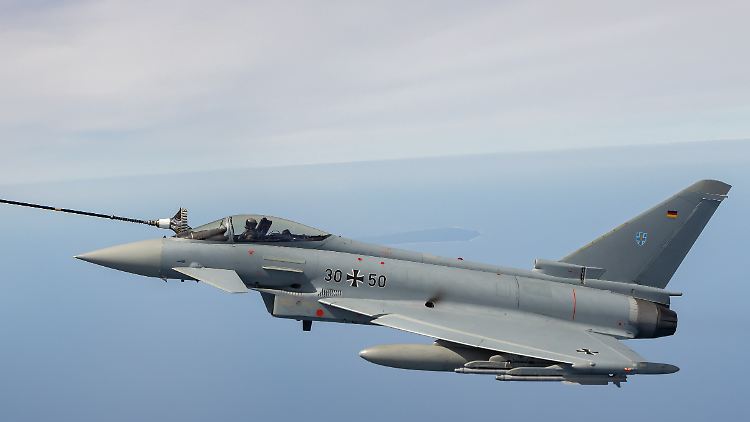Air Defender, NATO’s largest air-layout exercise to date, comes to an end this Friday. 250 military pilots from 25 countries are trained. German pilots of the A400M transport plane do their job as a flying gas station at an altitude of 10,000 meters. “No witchcraft,” they explain in an interview with ntv.de.
ntv.de: Air Defender is a huge training field for the Luftwaffe. What did you practice with the A400M transport plane?
Mark J.: As part of Air Defender, I’m assigned as an instructor on the tanker planes. I train the less experienced colleagues in aerial refueling. So I sit on the left, the “students” sit on the right, we then fly to the training area and are primarily available to the German Eurofighters for refueling. But other jets can also fill up on kerosene with us before they fly home.
Didn’t you fly to the training area alone today?
Mark J.: We flew in formation and I led our part. I had eight Jetties and a big bomber behind me. It was the first time for me in such a large formation and it was a lot of fun. Air-to-air refueling, as we call it, is ultimately a formation flight.
Sven M.: Of course we have flown together with other nations time and again in the past years. But not over German soil and not to this extent. We can practice our own tactical procedures and refine coordination with the other countries. The bottom line is that we learn every day at Air Defender and we are so thankful that the multinational forces are making such a mark here. Especially the Americans who came here with so many soldiers.
With the A400M, Mark J. and Sven M. act as a filling station above the clouds.
(Photo: Frauke Niemeyer)
Do you also refuel the aircraft of the other participating countries? The A400M is also approved for F-18 fighter jets, for example.
Mark J.: We primarily refuel German Eurofighters and Tornados, but also other aircraft types such as the Rafale or the F-18. It has to be tested whether the aircraft type is technically compatible with us, this also runs separately for each nation using the type. After that there is a release, and then we can also fill up the other guys.
You fly a completely normal A400M, which only mutates into a tanker when the kerosene tank is pushed into the hold. How many jets do you have tanks for?
Sven M.: It’s difficult to say because the number of jets requested varies greatly. If we start from Wunstorf, we have around 50 tons of fuel, i.e. 60,000 liters on board. We need a small part of it for our plane, the rest goes to the jets.
How exactly do you have to prepare this?
Mark J.: Let’s say there’s a big airborne mission tomorrow and we’re fueling many of the participating jets. Then everything is already planned today, so that tomorrow, when I get to work three hours before take-off, I get a list with exact details of which jet I can expect to be refueled at and when, and how much fuel the pilots each want. So I start perfectly prepared, and then all the changes come.
Are you used to the fact that the plan doesn’t apply after all?
Mark J.: One jet starts earlier or flies later, requiring more or less kerosene accordingly, while another cancels refueling altogether. It’s then my job to manage that in the air. If I’ve fulfilled all the planned orders, but there’s still, say, 10,000 liters of fuel on board, then we’ll just wait for more customers in the training area.
Are you circling in the sky as a mobile gas station?
Mark J.: Exactly, two to three hours I’d guess, and that’s when the Jetties just come to us. An advantage that we have with the A400M compared to other tankers: We can fly much faster.
Up to 800 kilometers per hour, says the Bundeswehr.
Mark J.: For the refueling process, we go to 500 kilometers per hour, which is also comfortable for the jetties, they can easily slow down to this speed. Initially, communication still runs via the station on the ground, from where the jet is directed to us. Then I take over and direct him to the left or right wing tip. In addition to the engines, there is also a container with a hose about 15 centimeters in diameter, which I can extend 20 meters out. At the end there is a kind of basket. The jets, in turn, have a suitable connection for this, the tank nozzle.

A Eurofighter maneuvers its fuel filler neck onto the kerosene hose of the A400M.
(Photo: Bundeswehr/Christian Timmig)
And the pilots of the jet can maneuver so precisely that they hit the basket with their nozzle? That has to be done manually.
Mark J: Yes. We also have cameras at the back of the plane and we can see exactly what the jet is doing behind us on two screens. When it has docked to the basket, we start refueling in the desired amount. We can deliver 1,200 kilos of kerosene per minute through the hose.
It takes less than ten minutes, but the fighter is very close to your rear the whole time. Sometimes two refuel at the same time – one on the left wing, one on the right. Is this as dangerous as it looks?
Sven M.: Flying in formation is not rocket science. But you have to train a lot for it, and that’s why we do this exercise. The pilots that we train here in the “A400M” are not totally inexperienced, but they have not yet done “Air to Air Refueling”. You might learn it in a classroom situation in the simulator, you might do your first flights outside and you will now be supervised again by a teacher.
Would you correct your own position to make it easier for the jet to maneuver?
Mark J.: No, the jet pilots have to do it themselves, for them it is actually the greater flying challenge. But they often practice flying in formation, they do it perfectly. Refueling is her daily business. We keep the gas flowing, they fill up as much as they need, drop back a bit, and we part again. It looks great, but is actually unspectacular.
Frauke Niemeyer spoke to Mark J. and Sven M

